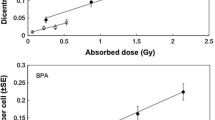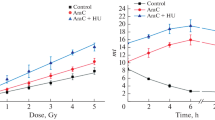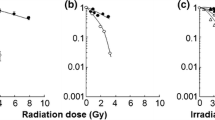Abstract
Purpose: We analyzed the time-course of changes in the sensitivity of total (proliferating + quiescent and quiescent (Q) cell populations within solid tumors in situ following a neutron capture reaction and compared it with that after γ-ray irradiation. Methods: After continuous labeling of proliferating cells with BrdU for 5 days, mice bearing SCC VII tumors received thermal neutron irradiation with or without a 10B-labeled compound (sodium [10B]borocaptate, BSH, or dl-p-[10B]boronophenylalanine, BPA), or γ-ray irradiation. From 5 min to 72 h after treatment, tumors were excised, minced, and trypsinized. Cell suspensions were incubated for 48 h with the cytokinesis blocker cytochalasin-B. The micronucleus frequency for BrdU-unlabeled cells, Q cells at treatment, was then determined by immunofluorescence staining for BrdU. The micronucleus frequency for total cells was obtained from tumors that had not been pretreated with BrdU labeling. The sensitivity was evaluated in terms of the frequency of induced micronuclei in binuclear tumor cells (micronucleus frequency). Results: Overall, Q cells showed greater repair capacities than total cells. γ-Ray irradiation and neutron irradiation with BPA induced larger repair capacities in each cell population. In contrast, thermal neutron irradiation without a 10B-labeled compound induced the smallest repair capacity in both cell populations. The use of a 10B-labeled compound, especially BPA, widened the difference in sensitivity between total and Q cells, resulted in an increase in repair capacity in both cell populations, and made the repair patterns of the two cell populations look like those induced by γ-ray irradiation. Conclusion: Differences in sensitivity and repair patterns following the neutron capture reaction were thought to depend on differences in the distribution of the 10B-labeled compound between the proliferating and Q cell populations.
Similar content being viewed by others
Author information
Authors and Affiliations
Additional information
Received: 18 February 1999 / Accepted: 4 June 1999
Rights and permissions
About this article
Cite this article
Masunaga, Si., Ono, K., Suzuki, M. et al. Repair of potentially lethal damage by total and quiescent cells in solid tumors following a neutron capture reaction. J Cancer Res Clin Oncol 125, 609–614 (1999). https://doi.org/10.1007/s004320050323
Issue Date:
DOI: https://doi.org/10.1007/s004320050323




